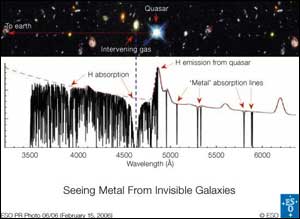The Invisible Galaxies That Could Not Hide

A distant quasar is used as a beacon in the Universe. Galaxies and intergalactic material that lie between the quasar and us will reveal themselves by the features seen in the spectrum.
Metal-Rich Distant Galaxy Found With ESO’s VLT
Astronomers, using the unique capabilities offered by the high-resolution spectrograph UVES on ESO’s Very Large Telescope, have found a metal-rich hydrogen cloud in the distant universe. The result may help to solve the missing metal problem and provides insight on how galaxies form.
“Our discovery shows that significant quantities of metals are to be found in very remote galaxies that are too faint to be directly seen”, said Celine Peroux (ESO), lead-author of the paper presenting the results [1].
The astronomers studied the light emitted by a quasar located 9 billion light-years away that is partially absorbed by an otherwise invisible galaxy sitting 6.3 billion light-years away along the line of sight.
The analysis of the spectrum shows that this galaxy has four times more metals than the Sun. This is the first time one finds such a large amount of ‘metals’ [2] in a very distant object. The observations also indicate that the galaxy must be very dusty.
Almost all of the elements present in the Universe were formed in stars, which themselves are members of galaxies. By estimating how many stars formed over the history of the Universe, it is possible to estimate how much metals should have been produced. This apparently straightforward reasoning has however since several years been confronted with an apparent contradiction: adding up the amount of metals observable today in distant astronomical objects falls short of the predicted value. When the contribution of galaxies now observed at cosmological distances is added to that of the intergalactic medium, the total amounts for no more than a tenth of the metals expected.
Studying distant galaxies is however a difficult task. The further a galaxy, the fainter it is, and the small or intrinsically faint ones won’t be observed. This may introduce severe biases in the observations as only the largest and most active galaxies are picked up.
Astronomers therefore came up with other ways to study distant galaxies: they use quasars, most probably the brightest distant objects known, as beacons in the Universe.
Interstellar clouds of gas in galaxies, located between the quasars and us on the same line of sight, absorb parts of the light emitted by the quasars. The resulting spectrum consequently presents dark ‘valleys’ that can be attributed to well-known elements. Thus, astronomers can measure the amount of metals present in these galaxies – that are in effect invisible – at various epochs.
“This can best be done by high-resolution spectrographs on the largest telescopes, such as the Ultra-violet and Visible Echelle Spectrograph (UVES) on ESO’s Kueyen 8.2-m telescope at the Paranal Observatory,” said Péroux.
Her team studied in detail the spectrum of the quasar SDSS J1323-0021 that shows clear indications of absorption by a cloud of hydrogen and metals located between the quasar and us. From a careful analysis of the spectrum, the astronomers found this ‘system’ to be four times richer in zinc than the Sun. Other metals such as iron appear to have condensed into dust grains.
“If a large number of such ’invisible’ galaxies with high metal content were to be discovered, they might well alleviate considerably the missing metals problem”, said Péroux.
The full text of this release along with an image is available at http://www.eso.org/outreach/press-rel/pr-2006/pr-06-06.html
Media Contact
More Information:
http://www.eso.org/outreach/press-rel/pr-2006/pr-06-06.htmlAll latest news from the category: Health and Medicine
This subject area encompasses research and studies in the field of human medicine.
Among the wide-ranging list of topics covered here are anesthesiology, anatomy, surgery, human genetics, hygiene and environmental medicine, internal medicine, neurology, pharmacology, physiology, urology and dental medicine.
Newest articles

Superradiant atoms could push the boundaries of how precisely time can be measured
Superradiant atoms can help us measure time more precisely than ever. In a new study, researchers from the University of Copenhagen present a new method for measuring the time interval,…

Ion thermoelectric conversion devices for near room temperature
The electrode sheet of the thermoelectric device consists of ionic hydrogel, which is sandwiched between the electrodes to form, and the Prussian blue on the electrode undergoes a redox reaction…

Zap Energy achieves 37-million-degree temperatures in a compact device
New publication reports record electron temperatures for a small-scale, sheared-flow-stabilized Z-pinch fusion device. In the nine decades since humans first produced fusion reactions, only a few fusion technologies have demonstrated…





















